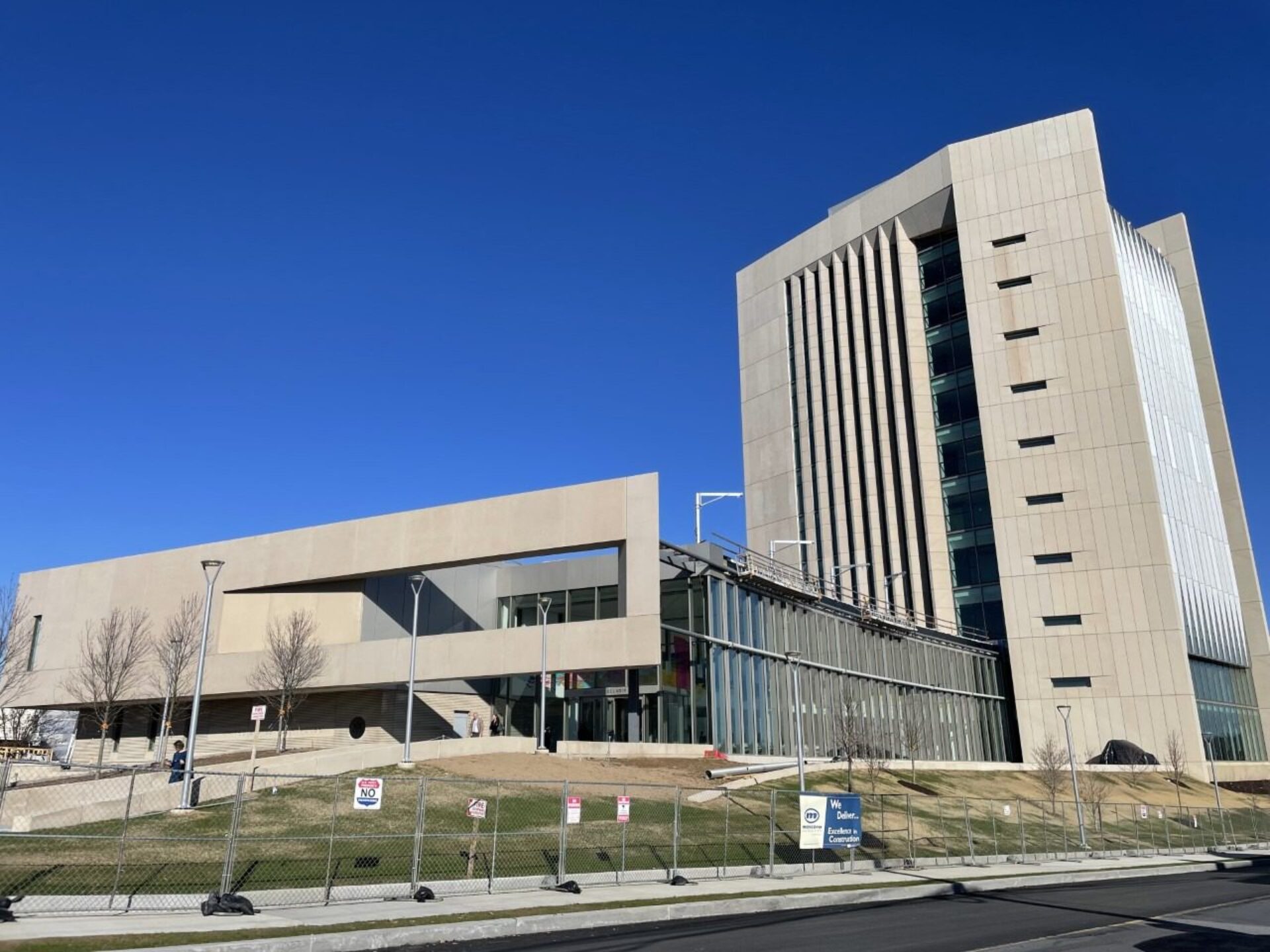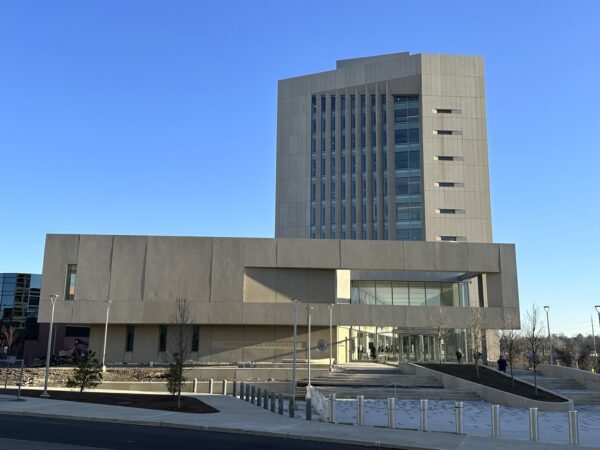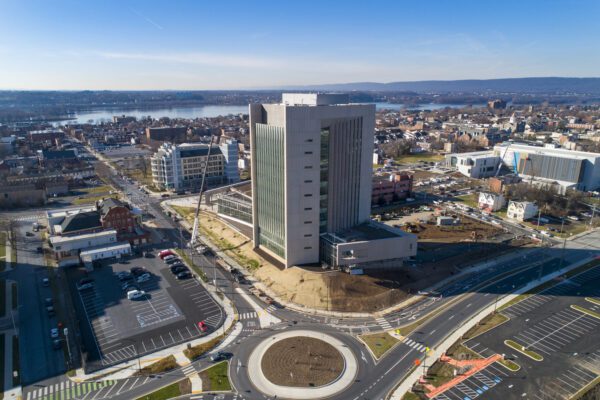
March 12, 2025 | Articles
Get Stoked: Hill International Makes Big Waves in Spain’s Surfing Scene

The Sylvia H. Rambo U.S. Courthouse, located in Harrisburg, PA, represents a significant addition to the U.S. General Services Administration’s (GSA) portfolio of federal courthouses. This facility was formally dedicated to Judge Sylvia H. Rambo, the first female chief judge of the U.S. District Courts for the Middle District of Pennsylvania, the new 243,000 SF facility replaces the former Ronald Reagan Federal Building and includes state-of-the-art sustainability and security features. Designed by Ennead Architects and constructed by Mascaro Construction, the courthouse features 8 courtrooms, 11 judges’ chambers, jury facilities, holding cells, and secured indoor and outdoor parking. The building is LEED Gold certified and incorporates advanced technology to accommodate the needs of the U.S. District Courts for the Middle District of Pennsylvania.
Hill managed the construction of the courthouse, using specialized tools like BIM modeling and ePM information controls to execute the project. In addition, the team’s role extended beyond construction management to planning the move-in process, with the goal of minimal disruption to court operations.

Maintaining court functions throughout the move process proved to be a key challenge for the Hill team. This required strategic planning to avoid downtime, using weekends and holidays for critical move phases. Regular meetings with tenants facilitated this process, evolving to enable a smooth transition to the new facility while keeping essential services like the U.S. Marshals Service and U.S. Bankruptcy Courts operational. Hill’s approach to the move, supported by detailed planning and effective stakeholder communication, was instrumental in the successful establishment of the courthouse and its functions.
Early Engagement and Planning
Proactive collaboration with future tenants was integral to the project’s success. This process began in 2021 during the design stage, with stakeholders from GSA and Hill initiating bi-weekly meetings with tenants. These regular touchpoints served as a platform for ongoing dialogue, confirming the design met the specific needs and expectations of the tenants.
Annie Wynn, Hill Project Coordinator responsible for managing the day-to-day aspects of the move-in process, emphasized the value of this approach: “Engaging tenants early in the design phase and throughout construction was essential. It allowed us to establish rapport and tailor the courthouse to their exact needs, making the transition as smooth as possible.”
Executing with Expertise: Integrating Construction and Move Management
During construction, the project team adopted a specialized integration strategy, with the Hill team simultaneously overseeing construction and the move-in process. This method facilitated a smooth transition from design and construction to occupancy. Integral to this strategy was the formation of a move team composed of stakeholders from GSA, Hill, and global real estate company CBRE, which guaranteed expert coordination between moving activities and ongoing construction. The Hill team’s decision to contract CBRE on behalf of GSA also played a vital role. CBRE’s expertise was key in selecting specialized subcontractors to help verify the requirements of the courthouse project were met.
Maintaining Operations: A Tenant-Focused Move Strategy
The team’s commitment to tenant needs was demonstrated through an engagement strategy that began more than a year prior to the move. The standing bi-weekly meetings during design evolved to support adaptive move planning with each tenant group. In this forum, Hill and partner teams discussed everything from preparation and packing instructions to furniture inventory, and from IT needs to post-move configurations. The team also placed special emphasis on maintaining security requirements–an important aspect for the courthouse environment.

David Rupp, Hill Vice President, highlighted the significance of these efforts: “Our planning sessions with tenants, alongside the integrated management of construction and move-in phases with flexible scheduling, were key to achieving a seamless transition. By thoroughly addressing each aspect of the move, we were able to maintain continuity in courthouse operations, which was our top priority.”
Creating a Positive Tenant Experience
The transition to the new Sylvia H. Rambo U.S. Courthouse was marked by a series of well-coordinated efforts, leading to positive feedback from the tenants. Central to this success was the strategic planning and support of the Hill team throughout the process.
A key factor in the project’s success was the development of meaningful relationships with stakeholders from each tenant group, facilitated through consistent and in-depth discussions every step of the way.
Annie reflected on the importance of this experience: “Really getting to know each stakeholder made a huge difference. We built strong relationships with the tenant groups and co-created our approach to meet their specific needs. This helped make the entire move smoother and more comfortable for everyone, ultimately benefiting the local judiciary system and the Harrisburg community.”
Share

March 12, 2025 | Articles
Get Stoked: Hill International Makes Big Waves in Spain’s Surfing Scene

March 9, 2025 | Articles
Project Manager TJ Pinales: Helping Along the Road in San Antonio

March 4, 2025 | Articles
Balancing the Equation: An Interview with Project Manager Tracy Wiyrick

March 1, 2025 | Articles
A Lifelong Project: Calypso Kyriakopoulou’s Multifaceted Career in Construction

February 10, 2025 | Articles
Dual Delivery: A Viable Strategy for Complex Transit Projects

January 23, 2025 | Articles
Plotting a Roadmap to Success on the Torres de Colón Renovation

December 12, 2024 | Articles
Progressive Design-Build for Rail and Transit Projects: Room to Run

December 9, 2024 | Articles
Unlocking Growth: Maximizing the Benefits of the SBA’s Mentor-Protégé Program

December 8, 2024 | Articles
Mediterranean Luxury a Century in the Making: Four Seasons Resort Mallorca at Formentor